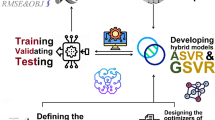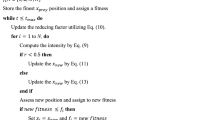Abstract
This research presents a new model for finding optimal conditions in the concrete technology area. To do that, results of a series of laboratory investigations on concrete samples were considered and used to design several artificial intelligence (AI) models. The data samples include 8 parameters i.e., silica fume replacement ratio, fly ash replacement ratio, fine aggregate, water content, high rate water reducing agent, coarse aggregate, total cementitious material, and age of samples, were used to predict and optimize the compressive strength of concrete samples. For optimization purposes, this study used a human learning optimization (HLO) algorithm to find the optimal results as well as optimizing the kernel coefficients of the support vector regression (SVR) models. Initially, to form the core of this research, various models were constructed and proposed to design the required relationship between the data using SVR. Since different SVR kernels have their own coefficients, using optimization theory, the probability of error in the models was reduced and the models were identified and executed with the highest accuracy. Finally, the polynomial model was selected as the model with the lowest computational error and the highest accuracy for evaluating the compressive strength of the concrete samples. The accuracy of the proposed SVR model for training and testing data was obtained as the coefficient of determination (R2) = 0.9694 and R2 = 0.9470, respectively. This function was considered as a relation, to be developed by the HLO algorithm to find optimal options under different conditions. The results for 14 samples, which are the most important examples of this research, showed that the optimal states are obtained with a high level of accuracy. This confirms the proper use/develop of the SVR-HLO algorithm in designing the predictive model as well as finding optimal conditions in the concrete technology area.















Similar content being viewed by others
References
Atiş CD (2005) Strength properties of high-volume fly ash roller compacted and workable concrete, and influence of curing condition. Cem Concr Res 35:1112–1121
Toutanji H, Delatte N, Aggoun S et al (2004) Effect of supplementary cementitious materials on the compressive strength and durability of short-term cured concrete. Cem Concr Res 34:311–319
Lam L, Wong YL, Poon CS (1998) Effect of fly ash and silica fume on compressive and fracture behaviors of concrete. Cem Concr Res 28:271–283
Babu KG, Rao GSN (1994) Early strength behaviour of fly ash concretes. Cem Concr Res 24:277–284
Sabir BB (1997) Mechanical properties and frost resistance of silica fume concrete. Cem Concr Compos 19:285–294
Mazloom M, Ramezanianpour AA, Brooks JJ (2004) Effect of silica fume on mechanical properties of high-strength concrete. Cem Concr Compos 26:347–357
Bhanja S, Sengupta B (2005) Influence of silica fume on the tensile strength of concrete. Cem Concr Res 35:743–747
Mansour MY, Dicleli M, Lee J-Y, Zhang J (2004) Predicting the shear strength of reinforced concrete beams using artificial neural networks. Eng Struct 26:781–799
Koopialipoor M, Tootoonchi H, Jahed Armaghani D et al (2019) Application of deep neural networks in predicting the penetration rate of tunnel boring machines. Bull Eng Geol Environ. https://doi.org/10.1007/s10064-019-01538-7
Koopialipoor M, Murlidhar BR, Hedayat A et al (2019) The use of new intelligent techniques in designing retaining walls. Eng Comput. https://doi.org/10.1007/s00366-018-00700-1
Zhou J, Li X, Mitri HS (2015) Comparative performance of six supervised learning methods for the development of models of hard rock pillar stability prediction. Nat Hazards 79:291–316
Zhou J, Li X, Shi X (2012) Long-term prediction model of rockburst in underground openings using heuristic algorithms and support vector machines. Saf Sci 50:629–644
Huang J, Duan T, Zhang Y et al (2020) Predicting the permeability of pervious concrete based on the beetle antennae search algorithm and random forest model. Adv Civ Eng. https://doi.org/10.1155/2020/8863181
Monjezi M, Mehrdanesh A, Malek A, Khandelwal M (2013) Evaluation of effect of blast design parameters on flyrock using artificial neural networks. Neural Comput Appl 23:349–356
Torabi SR, Shirazi H, Hajali H, Monjezi M (2013) Study of the influence of geotechnical parameters on the TBM performance in Tehran-Shomal highway project using ANN and SPSS. Arab J Geosci 6:1215–1227
Monjezi M, Amini Khoshalan H, Yazdian Varjani A (2011) Optimization of open pit blast parameters using genetic algorithm. Int J rock Mech Min Sci 48:864–869
Monjezi M, Ahmadi Z, Varjani AY, Khandelwal M (2013) Backbreak prediction in the Chadormalu iron mine using artificial neural network. Neural Comput Appl 23:1101–1107
Zhou J, Aghili N, Ghaleini EN et al (2019) A Monte Carlo simulation approach for effective assessment of flyrock based on intelligent system of neural network. Eng Comput. https://doi.org/10.1007/s00366-019-00726-z
Monjezi M, Khoshalan HA, Varjani AY (2012) Prediction of flyrock and backbreak in open pit blasting operation: a neuro-genetic approach. Arab J Geosci 5:441–448
Mohammed A, Rafiq S, Sihag P et al (2020) ANN, M5P-tree and nonlinear regression approaches with statistical evaluations to predict the compressive strength of cement-based mortar modified with fly ash. J Mater Res Technol 9:12416–12427
Mohammed A, Rafiq S, Sihag P et al (2020) Soft computing techniques: systematic multiscale models to predict the compressive strength of HVFA concrete based on mix proportions and curing times. J Build Eng. https://doi.org/10.1016/j.jobe.2020.101851
Salih A, Rafiq S, Mahmood W et al (2020) Systemic multi-scale approaches to predict the flowability at various temperature and mechanical properties of cement paste modified with nano-calcium carbonate. Constr Build Mater 262:120777
Ghafor K, Qadir S, Mahmood W, Mohammed A (2020) Statistical variations and new correlation models to predict the mechanical behaviour of the cement mortar modified with silica fume. Geomech Geoeng. https://doi.org/10.1080/17486025.2020.1714083
Zhou J, Li E, Yang S et al (2019) Slope stability prediction for circular mode failure using gradient boosting machine approach based on an updated database of case histories. Saf Sci 118:505–518
Zhou J, Qiu Y, Zhu S et al (2020) Estimation of the TBM advance rate under hard rock conditions using XGBoost and Bayesian optimization. Undergr Sp. https://doi.org/10.1016/j.undsp.2020.05.008
Yeh I-C (1998) Modeling of strength of high-performance concrete using artificial neural networks. Cem Concr Res 28:1797–1808
Koopialipoor M, Armaghani DJ, Hedayat A et al (2018) Applying various hybrid intelligent systems to evaluate and predict slope stability under static and dynamic conditions. Soft Comput. https://doi.org/10.1007/s00500-018-3253-3
Koopialipoor M, Ghaleini EN, Tootoonchi H et al (2019) Developing a new intelligent technique to predict overbreak in tunnels using an artificial bee colony-based ANN. Environ Earth Sci 78:165. https://doi.org/10.1007/s12665-019-8163-x
Xu C, Gordan B, Koopialipoor M et al (2019) Improving performance of retaining walls under dynamic conditions developing an optimized ANN based on ant colony optimization technique. IEEE Access 7:94692–94700
Zhao Y, Noorbakhsh A, Koopialipoor M et al (2019) A new methodology for optimization and prediction of rate of penetration during drilling operations. Eng Comput. https://doi.org/10.1007/s00366-019-00715-2
Ghaleini EN, Koopialipoor M, Momenzadeh M et al (2018) A combination of artificial bee colony and neural network for approximating the safety factor of retaining walls. Eng Comput 35:647–658
Zhou J, Yazdani Bejarbaneh B, Jahed Armaghani D, Tahir MM (2020) Forecasting of TBM advance rate in hard rock condition based on artificial neural network and genetic programming techniques. Bull Eng Geol Environ 79:2069–2084. https://doi.org/10.1007/s10064-019-01626-8
Zhou J, Qiu Y, Armaghani DJ et al (2020) Predicting TBM penetration rate in hard rock condition: a comparative study among six XGB-based metaheuristic techniques. Geosci Front. https://doi.org/10.1016/j.gsf.2020.09.020
Apostolopoulou M, Asteris PG, Armaghani DJ et al (2020) Mapping and holistic design of natural hydraulic lime mortars. Cem Concr Res 136:106167
Asteris PG, Nikoo M (2019) Artificial bee colony-based neural network for the prediction of the fundamental period of infilled frame structures. Neural Comput Appl. https://doi.org/10.1007/s00521-018-03965-1
Huang J, Alyousef R, Suhatril M et al (2020) Influence of porosity and cement grade on concrete mechanical properties. Adv Concr Constr 10:393–402
Ghasemi E, Kalhori H, Bagherpour R, Yagiz S (2018) Model tree approach for predicting uniaxial compressive strength and Young’s modulus of carbonate rocks. Bull Eng Geol Environ 77:331–343
Huang J, Sun Y (2020) Effect of modifiers on the rutting, moisture-induced damage, and workability properties of hot mix asphalt mixtures. Appl Sci 10:7145
Huang J, Zhang J, Ren J, Chen H (2021) Anti-rutting performance of the damping asphalt mixtures (DAMs) made with a high content of asphalt rubber (AR). Constr Build Mater 271:121878
Yang HQ, Li Z, Jie TQ, Zhang ZQ (2018) Effects of joints on the cutting behavior of disc cutter running on the jointed rock mass. Tunn Undergr Sp Technol 81:112–120
Liu B, Yang H, Karekal S (2019) Effect of water content on argillization of mudstone during the tunnelling process. Rock Mech Rock Eng. https://doi.org/10.1007/s00603-019-01947-w
Yang HQ, Xing SG, Wang Q, Li Z (2018) Model test on the entrainment phenomenon and energy conversion mechanism of flow-like landslides. Eng Geol 239:119–125
Yang HQ, Zeng YY, Lan YF, Zhou XP (2014) Analysis of the excavation damaged zone around a tunnel accounting for geostress and unloading. Int J rock Mech Min Sci 69:59–66
Yang H, Liu J, Liu B (2018) Investigation on the cracking character of jointed rock mass beneath TBM disc cutter. Rock Mech Rock Eng 51:1263–1277
Yang H, Wang Z, Song K (2020) A new hybrid grey wolf optimizer-feature weighted-multiple kernel-support vector regression technique to predict TBM performance. Eng Comput. https://doi.org/10.1007/s00366-020-01217-2
Cortes C, Vapnik V (1995) Support vector machine. Mach Learn 20:273–297
Wen L, Cao Y (2020) Influencing factors analysis and forecasting of residential energy-related CO2 emissions utilizing optimized support vector machine. J Clean Prod 250:119492
Ghezelbash R, Maghsoudi A, Carranza EJM (2019) Performance evaluation of RBF-and SVM-based machine learning algorithms for predictive mineral prospectivity modeling: integration of SA multifractal model and mineralization controls. Earth Sci Inform 12:277–293
Gui G, Pan H, Lin Z et al (2017) Data-driven support vector machine with optimization techniques for structural health monitoring and damage detection. KSCE J Civ Eng 21:523–534
Parsaie A, Haghiabi AH, Moradinejad A (2019) Prediction of scour depth below river pipeline using support vector machine. KSCE J Civ Eng 23:2503–2513
Wu H-C (2007) The Karush–Kuhn–Tucker optimality conditions in an optimization problem with interval-valued objective function. Eur J Oper Res 176:46–59
Wang L, Yang R, Ni H et al (2015) A human learning optimization algorithm and its application to multi-dimensional knapsack problems. Appl Soft Comput 34:736–743
Wang L, Wang X, Fu J, Zhen L (2008) A novel probability binary particle swarm optimization algorithm and its application. J Softw 3:28–35
Kennedy J (2011) Particle swarm optimization. Encyclopedia of machine learning. Springer, Berlin, pp 760–766
Zhou J, Guo H, Koopialipoor M et al (2020) Investigating the effective parameters on the risk levels of rockburst phenomena by developing a hybrid heuristic algorithm. Eng Comput. https://doi.org/10.1007/s00366-019-00908-9
Tang D, Gordan B, Koopialipoor M et al (2020) Seepage analysis in short embankments using developing a metaheuristic method based on governing equations. Appl Sci 10:1761
Huang J, Koopialipoor M, Armaghani DJ (2020) A combination of fuzzy Delphi method and hybrid ANN-based systems to forecast ground vibration resulting from blasting. Sci Rep 10:1–21
Pham BT, Nguyen MD, Nguyen-Thoi T et al (2020) A novel approach for classification of soils based on laboratory tests using Adaboost, tree and ANN modeling. Transp Geotech. https://doi.org/10.1016/j.trgeo.2020.100508
Acknowledgements
This research was funded by the Faculty Start-up Grant of China University of Mining and Technology (Grant no. 102520282).
Author information
Authors and Affiliations
Corresponding author
Additional information
Publisher's Note
Springer Nature remains neutral with regard to jurisdictional claims in published maps and institutional affiliations.
Rights and permissions
About this article
Cite this article
Huang, J., Sun, Y. & Zhang, J. Reduction of computational error by optimizing SVR kernel coefficients to simulate concrete compressive strength through the use of a human learning optimization algorithm. Engineering with Computers 38, 3151–3168 (2022). https://doi.org/10.1007/s00366-021-01305-x
Received:
Accepted:
Published:
Issue Date:
DOI: https://doi.org/10.1007/s00366-021-01305-x




